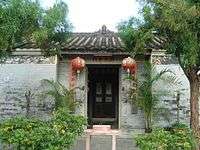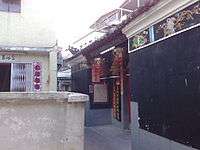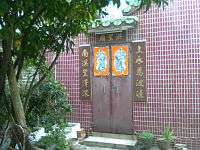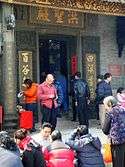Hung Shing Temple

Hung Shing Temples (Chinese: 洪聖廟) or Tai Wong Temples (大王廟) are temples dedicated to Hung Shing. Hung Shing temples have been widely built in southern China, especially Guangdong province[1] and in Hong Kong.
Hong Kong
Existing temples
There are several Hung Shing Temples in Hong Kong, including 6 on Lantau Island[2] and one only in urban Kowloon.[3] The table provides a partial list of these temples. Hung Shing Festivals (洪聖誕) are celebrated on the 13th day of the 2nd month in Chinese calendar at the Hung Shing Temples in Ap Lei Chau,[4] Tai Kok Tsui,[3] Cheung Chau,[4] Sha Lo Wan[5] and Kau Sai Chau.[6][7]
Note 1: A territory-wide grade reassessment of historic buildings is ongoing. The grades listed in the table are based on this update (10 September 2013). The temples with no status listed in the table below are not graded and do not appear in the list of historic buildings considered for grading.
Note 2: While most probably incomplete, this list is tentatively exhaustive.
| Location | Notes | Status | References | Photographs |
|---|---|---|---|---|
| Nos. 129–131 Queen's Road East, Wan Chai |
(See detailed article) This Hung Shing Temple was constructed before 1847, and used to overlook the sea front. Purely designed, this tile-roofed temple was built on large boulders against a craggy terrain. Subsequent to a number of land reclamations, it is now surrounded by modern commercial and residential buildings. |
Grade I |  | |
| On the hillside of Shau Kei Wan Road. Near No. 8 Shau Kei Wan Road, Shau Kei Wan |
The Hung Shing Temple and the adjacent Fuk Tak Temple were erected in 1980 and 1969 respectively. The Hung Shing Temple, originally located at Aldrich village, was moved to the present location when the village was demolished. The Fuk Tak Temple was moved from a place near the street end of the Shau Kei Wan Road to Chai Wan Road in the 1930s. After WWII, the Government developed the area near Chai Wan Road and the Temple was relocated to the present site.[8] | No grade | ||
| Ngoi Man Street, Shau Kei Wan |
Not listed | |||
| No. 9 Hung Shing Street, Ap Lei Chau |
This Hung Shing Temple is the oldest temple in the Aberdeen and Ap Lei Chau areas. It was built by local residents in 1773.[9] Managed by the Chinese Temples Committee.[10] The interior of the temple can be explored with Google Street View. |
Declared | ||
| Middle Island 22°14′05″N 114°11′07″E / 22.234795°N 114.185381°E |
Tai Wong Temple. | Not listed | ||
| Western end of Stanley Main Street, Stanley |
Tai Wong Temple. The Tai Wong Kung together with To Tei Temple is dedicated to Tai Wong. The date of construction of the building is unknown. The Temple enjoys good feng shui setting with its entrance oriented to the South, faced the Stanley Bay and backed by a forested knoll. The Temple consists of a row of three small houses which were built in line with the shape of the feng shui rock behind.[11] | No grade | ||
| 58 Fuk Tsun Street, Tai Kok Tsui |
This Hung Shing Temple was originally built in 1861 in the village of Fuk Tsuen Heung (福全鄉)[3] which was located at the intersection of Boundary Street and Tai Kok Tsui Road. In 1928, the Government developed the area and the Village was cleared.[12] In 1930, the temple was rebuilt at the present site, which was named after the Village, and it has since been managed by the Tung Wah Group of Hospitals.[13] It is the only Hung Shing temple in urban Kowloon.[3] | Grade III | ||
| Ngau Chi Wan Village, Wong Tai Sin District 22°20′07″N 114°12′33″E / 22.335392°N 114.209248°E |
Tai Wong Temple. |  | ||
| Near Ha Kwai Chung Tsuen, Kwai Chung. Located across Kwai Chung Road from Kwai Fong Terrace. |
Tin Hau temple. Partly dedicated to Hung Shing. Built prior to 1828, the original temple was relocated to the present site in 1966 to make way for the port reclamation in Kwai Chung.[14][15] | No grade | ||
| Opposite to Chui Kwai House, Kwai Chung Estate, Tai Wo Hau |
Tin Hau temple. Partly dedicated to Hung Shing. | Not listed | ||
| No. 31 Shui Tau, Kam Tin |
This Hung Shing Temple was built by the Tang Clan of Kam Tin more than 500 years ago. It was rebuilt in 1984.[16] | Grade II | ||
| Hang Mei Tsuen, Ping Shan |
This Hung Shing Temple was constructed by the Tang Clan residing in Ping Shan. It was probably built in 1767 during the Qianlong reign of the Qing Dynasty. The existing structure was rebuilt in 1866, followed by a substantial renovation in 1963.[17] It is part of the Ping Shan Heritage Trail. | Grade II |  | |
| Sha Kong Wai, Ping Shan |
||||
| No. 26C Cheung Shing Street, Yuen Long Kau Hui, Yuen Long |
This Tai Wong Temple was probably built between 1662–1722. It is the main temple of Nam Pin Wai as well as Yuen Long Kau Hui.[18] It was built for the worship Hung Shing and Yeung Hau.[19] Other than for worship, the temple was a venue for solving disputes and discussing market affairs among the villagers.[20] It also once served as a yamen and the officials lived there.[18] | Grade I |  | |
| Wong Uk Tsuen, Yuen Long |
Yi Shing Temple (二聖宮) in Wong Uk Tsuen is conventionally called Tai Wong Temple. It is mainly for the worship of Hung Shing and Yeung Hau deities. Renovation was carried out in 1924. It still acts as an alliance temple of the Tung Tau Alliance formed by the seven villages around Tai Wai Tsuen. In the old days, the temple operated a credit society serving the alliance villages.[21][22] | No grade | picture | |
| Tung Tau Wai, Wang Chau, Yuen Long |
The I Shing Temple (二聖宮) was built in 1718. It is dedicated to Hung Shing and Che Kung.[23] | Declared (1996).[24] | ||
| No. 73 Tin Liu Tsuen, Shap Pat Heung, Yuen Long |
The main shrine of the walled village is dedicated to Tai Wong, who is considered to be the protective deity of the village. Rebuilt in 1935, it lies on the central axis of the village together with the Entrance Gate and is a landmark of the village.[25] | No grade | ||
| Hung Leng, Fanling |
This Hung Shing Temple was probably built in 1763. It is the centre of the Four Yeuk (four villages alliance), namely Loi Tung, Lung Yeuk Tau, Lin Ma Hang and Tan Chuk Hang.[26] | Grade II | ||
| Ho Sheung Heung, Sheung Shui |
The Hung Shing Temple (left) and Pai Fung Temple (right) were originally two separate buildings built in different times. They were connected by a kitchen in the 1960s. While the construction date of the Hung Shing Temple is unknown, the oldest relics of the temple date to the 16th century. The Pai Fung Temple, originally located in Pai Fung Ling (排峰嶺), was moved to the present site in 1937.[27] | Grade II | ||
| Wai Loi Tsuen, Sheung Shui Wai, Sheung Shui Items No. 219 and 220 on map: |
Hung Shing Temple. Completely modern renovation. The temple comprises two halls and a central courtyard.[28] |  | ||
| Sha Tau, Ping Chau |
Tin Hau temple. Partly dedicated to Hung Shing. Built in 1765.[29] |
Grade III | ||
| Tsing Yi Lutheran Village, Tsing Yi 22°21′06″N 114°06′23″E / 22.351735°N 114.106426°E |
Tai Wong Pak Kung Temple (大王伯公廟) | |||
| Tsang Tsui (曾咀), Tuen Mun District |
||||
| Near Kau Sai Village, southern part of the island of Kau Sai Chau, Sai Kung District |
This Hung Shing Temple was built before 1889.[6] It is constructed in grey bricks with a timber roof frame. The temple has been renovated four times, in 1949, in the 1970s, in 1988 and the last being from August 1999 to February 2000.[30] The restoration was declared an "Outstanding Project" by the UNESCO Asia-Pacific Heritage 2000 Awards.[31] | Declared (2002) | ||
| Po Toi O, Clear Water Bay Peninsula, Sai Kung |
Hung Shing Temple. | Grade III | ||
| Tai She Wan (大蛇灣), High Island, Sai Kung 22°21′18″N 114°20′31″E / 22.355084°N 114.342023°E |
Hung Shing Temple. | |||
| Tung Lung Chau |
Shui Yuet Kung (水月宮).[32] Hung Shing Temple. | Grade III | ||
| Shek Tsai Po Street, Tai O, Lantau Island |
The Hung Shing Old Temple was built by the indigenous villagers in 1746. | No grade | .jpg) | |
| Tai Long Wan, West of Shek Pik, Lantau Island |
Built in 1960. Removed from Chung Hau, Shek Pik. The original temple was in ruins as in 1979.[33] | pictures | ||
| Tong Fuk, Lantau Island |
This Hung Shing Temple was founded in 1803, and was rebuilt in 1965 by the local villagers. Two other main deities namely the King of Fish Head and the King of Crystal Palace are also enshrined. | No grade | picture | |
| Mui Wo, Lantau Island |
This temple was originally located at Chung Hau but was reconstructed at Luk Tei Tong.[34] | |||
| Sha Lo Wan, Lantau Island |
Called Ba Kong Temple (把港古廟; "guarding the bay").[35] Built in 1774.[33] It is located to the right of the Tin Hau Temple, built in 1919. A wall is connecting the two temples at the front façade.[36] (Viewed from the front, the Hung Shing Temple is on the left) | No grade | ||
| Fan Lau, Lantau Island |
Ruins. | |||
| No. 1A Chung Hing Street, Cheung Chau Wan, Cheung Chau |
This Hung Shing Temple was built in 1813. Managed by the Chinese Temples Committee.[37] The interior of the temple can be explored with Google Street View. |
Grade II | ||
| Yau Kwong Street, Peng Chau |
.jpg) | |||
| Nos. 69A & 69B, Wing on Street, Peng Chau |
Tin Hau temple. Partly dedicated to Hung Shing. Probably built in 1792.[14] Managed by the Chinese Temples Committee. |
Grade II | ||
| Shek Pai Wan (石排灣). Between Tung O and Yung Shue Ha, Lamma Island |
Hung Shing Temple. Relic in this temple shows that it was probably built before 1824. It was built by the fishing and farming community in Tung O. | No grade |
Former temples
Several temples have been ruined and have disappeared, including:
- Temple at Mui Wo. Built in the Ming Dynasty, repaired in 1843. Completely disappeared.[33]
- Temple at Chung Hau, Shek Pik. Ruined as in 1979. A new temple was built in 1960 at Tai Long Wan.[33]
- Temple at Pui O. Built in the Ming Dynasty. Ruined as in 1979.[33]
- Temple in Tung Chung, inside Tung Chung Fort. Ruined as in 1979.[33]
Other locations
| Location | Notes | References | Photographs |
|---|---|---|---|
| Pengjiang District, Jiangmen, Guangdong Province, China | Hong Sheng Temple |  | |
| Yiu Ming Temple, 16–22 Retreat Street, Alexandria, Sydney, New South Wales, Australia. |
Yiu Ming Temple is the only temple dedicated to Hung Shing in Australia. Constructed in the 1870s by Sydney's Chinese Community, it was rebuilt in 1908. The interior was decorated in 1909–1917. The temple was restored in 1998–1999 following a fire. It is of historical significance to Sydney's Chinese community. It is architecturally significant for its combination of Cantonese design, local Sydney materials and Federation era Australian detailing. The building is substantially intact since construction.[38] | Yiu_Ming_Temple-2.jpg) | |
| Hung Shing Temple, No.31, Jln 4/48, Jalan Padang, 46050 Petaling Jaya, Selangor, Malaysia. |
Hung Shing Temple, Petaling Jaya, Selangor was constructed in the early 1900s by Petaling Jaya Chinese Community. Contact details : +60377831823. |  |
See also
References
- ↑ Brief Information on Proposed Grade I Items, pp.207–208 Archived 13 October 2012 at the Wayback Machine.
- ↑ Introduction to 1444 Historic Buildings, p.1363
- 1 2 3 4 Brief Information on Proposed Grade III Items, p.794 Archived 22 September 2013 at the Wayback Machine.
- 1 2 Chinese Temples Committee website
- ↑ Hung Shing Festival in Sha Lo Wan (Chinese)
- 1 2 Antiquities and Monuments Office: Hung Shing Temple on Kau Sai Chau
- ↑ Birthday of Hung Shing Kung in Kau Sai (with video)
- ↑ Introduction to 1444 Historic Buildings. Item #1298
- ↑ Chinese Temples Committee website – Hung Shing Temple, Ap Lei Chau
- ↑ Chinese Temples Committee: Hung Shing Temple, Ap Lei Chau
- ↑ Introduction to 1444 Historic Buildings, p.1366
- ↑ Tai Kok Tsui Temple Fair
- ↑ Tung Wah Group of Hospitals – Services Centres Information
- 1 2 Antiquities and Monuments Office: Introduction to 1444 Historic Buildings
- ↑ Kwai Tsing: Hong Kong's nucleus of trade
- ↑ Introduction to 1444 Historic Buildings, p.988
- ↑ Introduction to 1444 Historic Buildings, p.476
- 1 2 Introduction to 1444 Historic Buildings, p.178
- ↑ thaiworldview.com – Nam Pin Wai and Sai Pin Wai villages
- ↑ Brief Information on Proposed Grade I Items, p.354 Archived 13 October 2012 at the Wayback Machine.
- ↑ Brief Information on No Grade Items, pp.214–215 Archived 15 October 2012 at the Wayback Machine.
- ↑ Introduction to 1444 Historic Buildings, p.1207
- ↑ Antiquities and Monuments Office: I Shing Temple
- ↑ Environment Protection Department – List of Declared Monuments as on 1 January 1999 Archived 28 October 2009 at the Wayback Machine.
- ↑ Introduction to 1444 Historic Buildings, p.913
- ↑ Introduction to 1444 Historic Buildings. Item #1044
- ↑ Introduction to 1444 Historic Buildings, p.887
- ↑ East Rail Extension Project: Test Pits Results and Cross-Section Drawings
- ↑ Brief Information on proposed Grade III Items Archived 22 September 2013 at the Wayback Machine.. Item #1022.
- ↑ Weatherman Extraordinaire – Hung Shing Temple, Kau Sai Chau (archive)
- ↑ UNESCO Asia Pacific Heritage 2000 Awards for Culture Heritage Conservation: Hung Shing Old Temple
- ↑ Chinese Temples Committee: Shui Yuet Kung (Hung Shing Temple)
- 1 2 3 4 5 6 Siu, Anthony K.K. (1980). "Distribution of temples on Lantau Island as recorded in 1979" (PDF). Journal of the Royal Asiatic Society Hong Kong Branch. 20: 136–139. ISSN 1991-7295.
- ↑ Exploring Islands: Mui Wo. Hung Shing Temple.
- ↑ Brief Information on No Grade Items, pp.263–264 Archived 15 October 2012 at the Wayback Machine.
- ↑ Brief Information on No Grade Items, pp.229–230 Archived 15 October 2012 at the Wayback Machine.
- ↑ Chinese Temples Committee: Hung Shing Temple, Cheung Chau
- ↑ Heritage Council of NSW: Yiu Ming Temple
| Wikimedia Commons has media related to Hung Shing Temples in Hong Kong. |